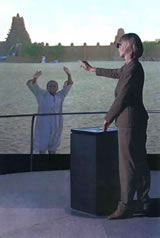Technical Description
1. Camera Design and Production
The camera design was based on 2 cameras (for stereo), 60 degree horizontal FOV lenses (for immersion), and a slowly rotating tripod (for panoramics), rotating once per minute (1 rpm). This is a compromise since it takes a minute to capture an entire 360 degree scene, but using multiple camera pairs to capture the entire scene at once was not practical. Sunlight variation was assumed to be negligible during the course of a minute, so using multiple images from the same scene for projection or panoramic tiling would have artifacts only from moving objects. A 1 rpm closed-loop crystal synchronized motor was mounted on a tripod. The question of how to arrange the cameras with respect to the axis of rotation resulted in lively debate. Mimicking mammal head rotation suggested placing both cameras symmetrically in front of the axis of rotation. A colleague, John Woodfill, had a novel suggestion: rotate the camera pair around the nodal point of one of the cameras. Such a configuration would result in a perfect 2D panorama from one camera and would place all of the disparity difference in the other camera.
After much deliberation, it was decided to use 35mm motion picture film. The resolution would be 4 times greater than 16mm film and much greater than video, particularly with respect to dynamic range. It is also well-known that 35mm motion picture cameras are simple yet durable and time-tested, with less likelihood of failure than video in the field. Arriflex cameras with Zeiss lenses were selected. The size of the cameras made it difficult to obtain normal human interocular distance, so an exaggerated interoccular distance of 8 inches was used.
It was further decided to film at a frame rate of 60 frames per second (fps). Such footage
could be transferred to video with each film frame corresponding to a single video field (half-frame). The result would have the best qualities of both film and video: it maintains the high dynamic range of film while having the motion smoothness of video (which updates at 60 fps). A sync box made by Cinematography Electronics was used to synchronize both cameras to a single controller, which allowed syncing phase as well as frame rate. The shutters were closed down to 30 degrees, resulting in an exposure time of 1/720 second, fast enough to freeze most everything.
Color negative film daylight-balanced with an ASA of 50 was used. Since all filming was to take place during daylight, the low ASA coupled with fast shutter speed wouldn't be a problem, with most filming possible at apertures between F4 and F11. Using stereoscopic 35mm cameras with high quality lenses and low-speed film, running at 60 fps, and with synchronized shutter and rotational speeds would result in unrivaled fidelity. It would, at the very least, have 5 times the resolution of theatrical 35mm film (twice the spatial and 2.5 times the temporal resolution).
A pro-DAT audio recorder with a shotgun microphone was used to collect sounds at each site for later mixing into 4 channel rotating sound. Enough stock to film 5 panoramas (10 reels of 400' film) was taken to each site. Miraculously, production stayed on schedule and everything came out.
2. Playback System
After production, the film was transferred to videotape, edited and mixed with the audio, then transferred to 2 laserdiscs. A simple input pedestal was made to allow site selection. Three scenes from each site were selected and aligned with each other such that perfectly registered time-of-day changes could be experienced within the same location.
"Be Now Here" would retain realtime motion and sacrifice browsability, enabling the user to control place and time but not speed. People movement would appear natural and coupled audio would be possible. This decision was based on the difference between footage of moving along long pathways (where browsability is desirable) and footage which, literally, goes around in circles.
A 12 by 16 foot highly reflective front projection screen would be used in conjunction with dual polarized video projection. The input pedestal would be strategically placed approximately 14 feet in front of the screen to entice the viewers to stand at the orthoscopically correct spot. The audience would wear inexpensive polarized glasses. The obvious way to achieve spatially correspondent playback would be to rotate the projected image around the viewing space, another moving movie. But this proved impractical given the need for wide-angle projection. The solution: rather than rotate the projection around the static audience, to rotate the audience inside a static projection.
A 16 foot diameter rotating platform was used, rotating at 1 rpm in sync with the imagery. The audience, limited to 10 at a time, stands on it (standing seems more desirable for ambient rather than narrative media). A black tent-like cylindrical structure surrounded most of the viewing space to mask out the non-rotating world.
Extracts from: Michael Naimark: "A 3D Moviemap and a 3D Panorama", SPIE Proceedings Vol. 3012, San Jose, 1997.


